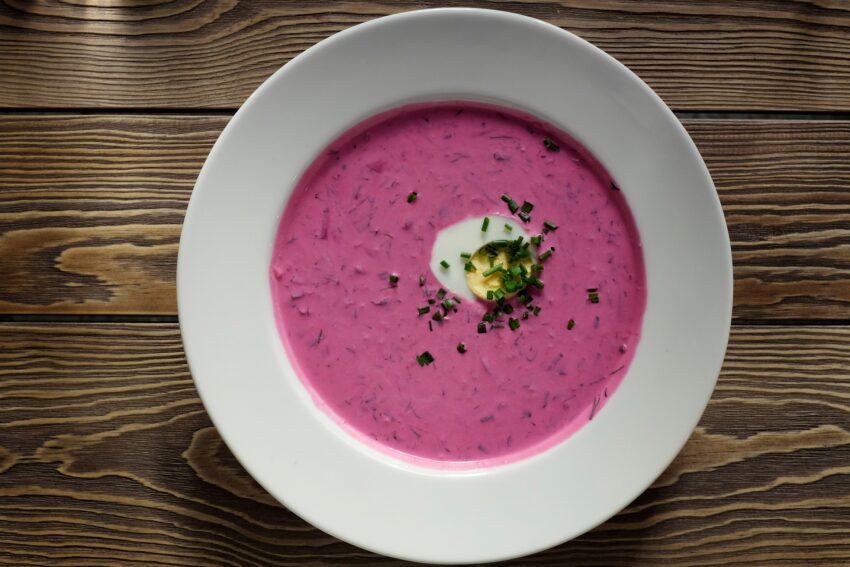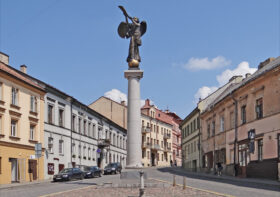The Disturbing Truth About Lithuania’s Famous Cold Beetroot Soup (šaltibarščiai)

If you’re a tourist or a foreigner that has spent more than a few days in Lithuania, you’ll likely have been informed about the need to try the country’s famous cold beetroot soup, which the Lithuanian’s call šaltibarščiai.
This Lithuanian name literally translates to cold borscht, as the word for ‘cold’ in Lithuanian is šalta, while the word for borscht is barščai.
Lithuanians are extremely proud of šaltibarščiai. It’s cited frequently in tourism material and tends to make the list of ‘must try’ foods when visiting Lithuania. Visiting some souvenir shops and tourist-oriented gift shops, you might even see products that feature this bright pink bowl of soup.

So what’s the “disturbing” truth about šaltibarščiai?
Is it overpriced? Overrated? Actually, no. It’s typically not too expensive, and it’s actually quite enjoyable!
The truth is that the photos below aren’t search results for šaltibarščiai.

These are actually search results for Aukstá Zupa, which is a cold beetroot soup dish from Latvia. You’ll see similar images when searching khaladnik (халаднiк) – the name of the cold beetroot soup from Belarus.
There is significant overlap for all three dishes:
- Beetroots and kefir form the base
- Most recipes for all three call for boiled eggs, green onions, and dill
- Dish served cold
So, in a sense, šaltibarščiai isn’t THAT unique to Lithuania – despite the vibe given off by tourism organizations and gift shops.
Šaltibarščiai beyond borders
The fact that there are šaltibarščiai-type dishes all over the region is unsurprising. While yes, Lithuania is very culturally unique, there are many cultural similarities with its neighbors – given a shared history over the centuries. In fact, the Grand Duchy of Lithuania, at its largest, covered areas that are now part of modern-day Latvia, Russia, Belarus, and Ukraine.
Funny enough, Poland has a cold beetroot soup too called chłodnik litewski. And in this case, since litewski literally translates to “Lithuanian” – the Poles at least consider the dish to be a Lithuanian thing and not a fully Polish dish.
To be clear, As far as I can see from my research, cold beetroot soup seems to have its origins in Lithuania! But the point of this piece is to say that the soup is not exclusively Lithuanian in this modern day and age, even if it was once upon a time..
Is Lithuanian šaltibarščiai different at all?
This was a difficult question to answer. I think every household could have its own recipe and its own unique twist. The official Vilnius tourism site even says this about it:
“There are many variations of the recipe—with yogurt, quail eggs, or sparkling mineral water. However, the one that packs a punch follows a fail-safe classic recipe: marinated beetroots, grated cucumbers, hard-boiled eggs, diced dills and spring onions, kefir, and a dash of salt are combined together in a bowl. Best served cold with a side of hot potatoes.”

Comparing this with recipes found for Aukstá Zupa and khaladnik, it’s clear that Latvians are used to enjoying their version with rye bread, while some recipes for khaladnik mentioned the option of bread OR boiled potatoes.
One Auksta Zupa recipe mentioned serving the cold soup with some sausage. And I’m sure even some Lithuanian restaurants will have their own creative, special variations of šaltibarščiai to stand out from the crowd.
What makes šaltibarščiai special in Lithuania
Despite neighboring countries having soups that are either identical or NEAR identical to Lithuanian šaltibarščiai, I don’t think any of the other countries have embraced their cold beetroot soups in the same way that Lithuania has.
Many Lithuanians will recall childhood (or even their current lives) including a cold bowl of this soup on a hot summer day. It indeed seems to be part of the collective memory of the country.

Whether it’s the work of a tourism development board or some other organization, šaltibarščiai seems to be something that is truly celebrated in Lithuania and very much tied to contemporary national identity. The same cannot be said of šaltibarščiai-analogs in neighboring countries.
So, there you have it – other countries have soups that are just like Lithuanian šaltibarščiai, but, it’s only in Lithuania that the dish has become such a major cultural symbol.
What do you think about Lithuania’s love of šaltibarščiai? Is it understandable and justified? Is it over-the-top? Or is it simply awesome? Let me know what you think by leaving a comment!



